Delightful Ko Samui (1 / 5) – Chaweng Beach And People
1 p.m. – Bangkok Airways drops me ten minutes early on Ko Samui. Everybody finds the airport here cute, I see just a cheap woodsy third-world shack; maybe "Asia's boutique airline" would call this, their company-owned airport, a "boutique
airport"? (It's more an airport boutique.) The childish carts that take you from the plane to the arrival sala feel like Disneyland.
It is my very first time on Ko Samui, in fact it is my very first visit of southern Thailand. I travelled extensively around the globe; in Asia alone, I spent months on end in each of Nepal, India, Indonesia, Laos, Cambodia and Vietnam; in Isaan, NE Thailand,
I patronized every single noodle stall between Ubon Rachathani and Nongkhai and every live music pub from Nakhon Phanom to Khon Khaen. But I never tried Phuket, Samui or any other of the dream places in Thailand's south. So Ko Samui also
is my very first encounter with Thai style handling of mainstream mass tourism.
It is 1 p.m. on a stinking hot day in mid May 2004. This is the height of the hot, dry season, but not the main tourist time. I stumble out of the airport shack. Ko Samui, I'll check you out. Chaweng beach comes first.
Service Mentality
Right from the very first steps there is this undelightful service mentality. I had gotten comfortably used to all the royal treatment I received in Asian backwaters, but here on Samui they slap me by the minute. I take a minibus to Chaweng beach, which
is about four kilometres away. Hey, it is only 100 baht for four kilometres, being squeezed in with ten other farangs! Stupidly, the full minibus stands around for 15 minutes; why hurry, we are all on holidays.
My suitcase looks like 50 kilograms. Well, according to Bangkok Airways, it is 24.8 kilograms. There are two more heavy pieces of carry-on-luggage dangling around my neck. (On other routes, Bangkok Airways would give me hard times with more than 24.99
kilograms of checked luggage.) The driver tells me to put my bag on the rooftop of his minibus. It is stinking hot at 1 p.m., and he suggests I alone swing my 25 kg bag onto his minivan. I have had many overland bus trips across SE Asia, from
chilly northern Laos to steaming southern Vietnam, and always there were guys assigned to shoving your stuff up to the roof and fixing it there. But on trendy upmarket Ko Samui, on a 100-baht-for-four-kilometers bus, the valued customer is expected
to do the job himself. Finally, seeing me struggling with my fat suitcase, the driver helps me; I guess he fears scratches on his shiny vehicle. The bag is not tied to the roof rack.
We arrive at Chaweng Garden Beach, my pre-booked bungalow place, the bag still being with us. The female receptionist asks if I am alone. I confirm this. She smiles wittily and gestures at me like "Oh, you naughty naughty boy, I know what you are
up to". After that she shows me an English paper that advises me to check in valuables at the reception. She implies I bring stealing whores to the resort.
A first walk on the beach. Full, beautiful, and very hot. Something cold and sweet might be fine before dinner. A snack shack has a billboard for Wall's ice-cream. The following conversation takes place in clear Thai language, and I know that my
shopping Thai is understood by all and sundry. On the billboard, I point to the picture of Cornetto Lime and ask the lady: "Do you have Cornetto Lime?" – "Yes, we have." – "Ok, one Cornetto Lime please." – She gives
me a Cornetto Orange. – I say "Sorry, I ordered Cornetto Lime" and point to the Cornetto Lime picture again. – "We don't have Cornetto Lime." – I take Cornetto Orange. At a 7-11 it costs 17 baht, here it is 30 (later I
learn that beach hawkers charge 50). The consistency is that of a dead pudding. It tastes like recycled paper. It is air temperature. But there is no trash bin. I discard the Cornetto Orange behind a bush, unsure though if it is really organic
waste; I put the greasy ice-cream paper into my daypack, between laptop and reading.
Later, dinner on the beach. A small beer Singh here is 40 to 60 baht at happy hour. You get your beer bottle from the fridge, but it is not excitingly cold. They don't pour the beer into your glass here. Maybe they are too ashamed that there is no
ice in your glass? (One beach further south, on Lamai, they pour. Yet one beach further south, on Hua Thanon, they ask to pour or not.)
The service mentality persists on later days. I stop the rental Honda on the parking lot at Grandmother and Grandfather Rock, a local tourist attraction; here Thai and farang tourists admire a penis shaped piece of stone towering over south Lamai Beach.
An attendant rushes by and requests 10 baht parking fee. For this, he throws a piece of paper into the motosai's basket, I get no receipt – very useful. As I fancy a lengthy beach walk with en suite dinner, I might come back well after dark.
So I ask him how long this parking lot is open. He can't tell. He can't understand my otherwise useful tourist Thai. He can't speak one word of English. No, that's wrong, "10 baht" he could say, but just no more.
But his "10 baht" mantra is obsolete, as they already have a huge billboard that says just that: "10 baht", in roman script. Unfortunately, they do not have a huge billboard with their business hours. I pull out, park the motosai
in the next bungalow resort, smile at security and have the best motosai parking I could dream of.
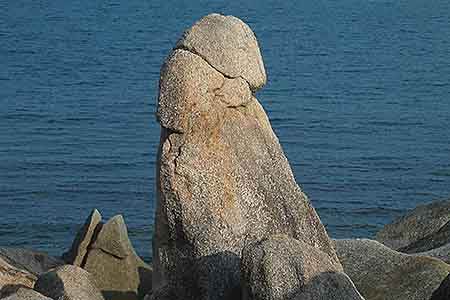
Bangkok Airways adds to the good impression of local service-mindedness. I want to ask a short question at the reservations desk. As they own Ko Samui airport, Bangkok Airways has a monopoly for flights into Samui. Their Bangkok-Samui planes are often
fully booked. They are way more expensive than comparable Thai routes. The Ko Samui office has three terminals – but only one clerk on duty. Four other customers are already queuing up. I wait 30 minutes until I can pose my little question, and
then the clerk is unfriendly. (By comparison, for Bangkok-flights from Phnom Penh, Bangkok Airways heftily competes with at least two other airlines. Their Phnom Penh planes are often half empty. They are way cheaper than Thai. The Phnom Penh
office always has three clerks on duty. You wait 0 minutes, and the clerks are friendly.)
Tesco Lotus keeps me wondering, too. Some items do have a tag with a bar code, but no price information. So customers have to queue up at a wall-mounted self service bar code scanner to learn how expensive that plastic coffee cup might be.
Chaweng Beach
I knew before that Chaweng beach is the main tourist drag and thus not my typical destination. I booked a few days anyway. I thought at Chaweng it would be easy to rent a 110 ccm Honda Dream for island-wide pothole research; also here I wanted to grab
more information, and I wanted to check the nightlife. But I get stuck on Chaweng for a long time: Many other beaches are not ok for swimming. And the west coast beaches have direct sunshine in the afternoon, which is too hot for my ritual afternoon
stroll – even though I can't see the sunset then.
Sheltered by a rubble reef and tiny islands, the northern half of Chaweng beach is very calm and shallow. Actually, at low tide in the dry season, it looks a bit muddy there and not too inviting. On this part are many posh resorts like Amari Palm Reef,
Chaweng Regent, Blue Lagoon or tiny, tempting Palm Island. You find interesting, characterful midrange options like the Mediterranean themed Corto Maltese or the fantasy style Papillon resort, one of the few places that don't line up all
their bungalows in military order. Just halfway to the south, where the beach bends around, Chaweng opens and gets some harmless waves. Still it is shallow, thus very kid-friendly. It is easy to lounge in the water, and you can walk out almost
all the way to Ko Chang or Cambodia. This place on central Chaweng beach is like a beach within the beach, it actually feels like a marine piazza, as so many tourists like to splash here. Around this part of the beach are mostly cheaper establishments
for backpackers and the party people; so you sit in the delightful green-blue-silvery fluidum between tattooed dyed hipsters, baking your head and cooling your body.
Several brainless speedboaters roar around central Chaweng beach, helping me to avoid over relaxation. Surprisingly they ram none of the swimmers; the last such accident, I am told, was eight years ago. I ask one of the tattooed, dreadlocked speedboat
renters for the rates. He says 3000 baht per hour, then goes down to 2500. By comparison, a small jeep can be had for 800 baht; per day.
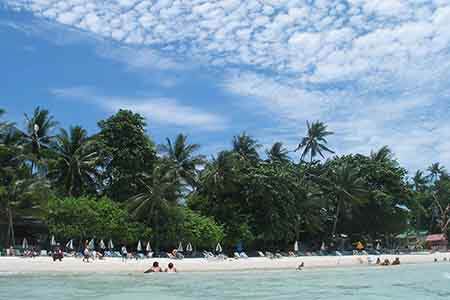
As my feet dig further south, Chaweng beach gets straight and broader and even a bit monotonous, like those airstrip beaches in Brazil. Here, super posh places for the tour group crowd mix with relative cheapies. The shallow, but very clear and not muddy
water is quite warm and a delight for waterline strolls or lazing in the waves.
Interestingly, seen from the waterline or from inside the ocean, you almost can't notice the resorts. Their beach front buildings hide below palm tree line, and you get the impression of a relatively undisturbed water front. If they do need a huge
impressive building, it is more inland, facing the beach road, not the beach. By contrast, other beaches like Lamai or Choeng Mon have quite obtrusive landmark constructions right on the waterfront.
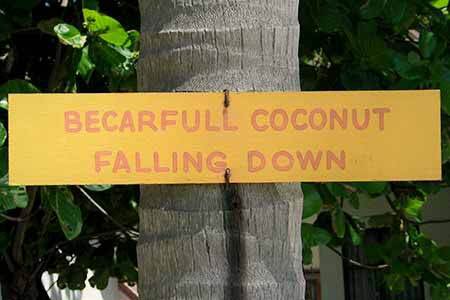
A rocky headland is the southern end of Chaweng beach. I tiptoe across the stones to arrive at Chaweng beach's little sister, called Chaweng Noi. It is another delightful crescent of powdery white sand and turquoise waters, maybe two kilometers long.
The water is sparkling green, shallow and not the least muddy – all in all the sand-water-quality is even a tad above the main Chaweng beach. During my stay, I regularly like to come to Chaweng Noi by motosai, taxi or beach walk, as splashing
here is most peaceful – almost no speedboats! I set up shop on one of the beach chairs that the Fair House resort gracefully supplies, and hang out for some hours. The scene here is most different from main Chaweng beach: There are only three
or four resorts including Fair House, Samui New Star and Impiana; they all charge between 2000 and 7000 baht per night at low season and have no special theme or ambience. I see many elderly couples snoozing in the chairs, and I hear a lot of
German. Very sedate. One cheerful Farang-Thai-couple draws disapproving stares from the otherwise all-white beach users. This is so different from big Chaweng, where all kinds of cosmopolitan people share the waves: backpackers, ladyboys, regular
tourists, Thai tourists, Thai locals, plus elderly punters with their night-fresh Isaan catch, they all peacefully have a good time side by side. Behind Chaweng Noi there is no beach road, but it faces noisy boring ring road; so when lodging there
you have no immediate distraction or dining alternative to the few resorts.
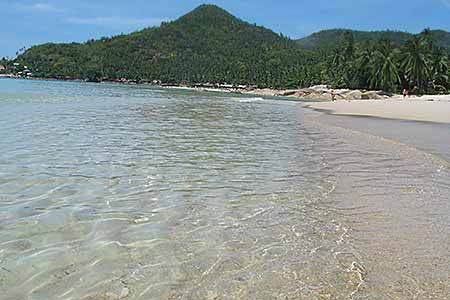
I am not used to that kind of holiday, beach holiday, but I can enjoy it. I spend whole days without wearing long trousers or any footwear. I'd never do that anywhere in Asia, but on Ko Samui I walk with bare feet and shorts into internet shops,
travel agencies and mini-markets – they face the beach. On some evenings I squeeze the flip flops into a plastic bag and the plastic bag into a pocket of my shorts; bare feet I walk for hours on the beach, for some moonlit cocktails and spring
rolls on the waterline. I promenade along shops and restaurants right in the sand. Only when I make it to the main road for more shopping or nightlife, I take out the flip flops. Heck, even some Thais go out that way.
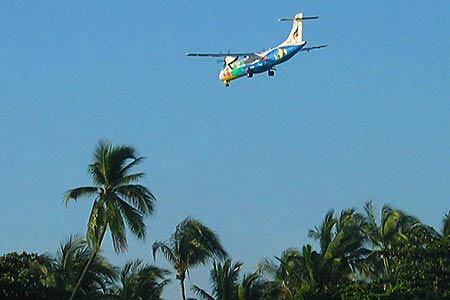
On Chaweng beach, you are constantly approached by snack and souvenir hawkers, tour boat touts and by Thai massage ladies. On some days it gets noisy loudspeaker boats announcing kickboxing events. Tourists dart on noisy speedboats through the waves.
Every 20 minutes Bangkok Airways scratches the palm trees. A few parasailers hang in the air, too. After dark resto touts and flower sellers talk to you. Between them, the resto billboards and the resto tables there is often no place to pass by
without getting wet feet; at least at high tide.
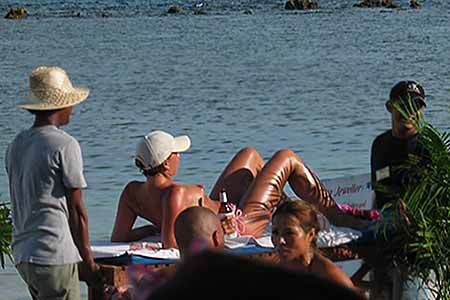
Pale and untattooed, on my first day I feel not only old, but a bit nude walking around the hip twenty-something crowd that packs central Chaweng beach. Mostly they boil right in the scorching sun. A few Thai girl friends sit under an umbrella besides
their sweating farang teelac who stretches out into the rays. A few farang ladies lost their bikini top, and the tanga strings are stuffed deep into the ass. Those western women reveal more than your average Thai gogo dancer, they look more sexy,
yet they aren't available for 500 baht per pop, or should I ask? A complete, but diminutive bikini most delicately filled with a smiling Thai female approaches me – beautiful, have I ever seen a Thai lady in bikini, on the beach I mean? Before
I even can say "Your place or mine", I receive a bush of tourist flyers, and off she is.
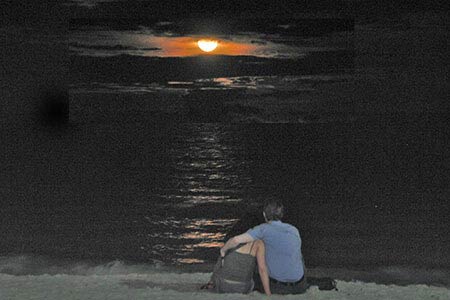
I also like my late night strolls along the beach, between midnight and 2 a.m. Tired waiters remove chairs and tables from the sand, for this they even change the PA to Thai music. Security guards with ties and black shoes roam the sands in front of the
posher resorts. Still you can walk into their gardens and look at the blue shimmering pools and lit-up palm trees. The poolscape at the Amari Palm Reef Resort is especially amazing, and they have this mundane open poolside bar, lit in halocinogenous
colours, bubbling with chill out music. On these dark late night strolls I meet couples taking to the waters stark naked; couples taking to beach chairs in unprecedented manners, assisted by excited beach dogs; singles taking to themselves. Finally,
strolling home, I always encounter Mr. Wetman. I clean my bare feet under the outdoor shower, and then he hops away, but in no hurry: Mr. Wetman, my cute green-brown beachside frog.
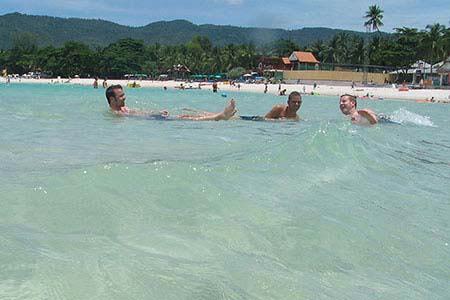
Yep, that's Chaweng beach. I forgot to mention, it is beautiful indeed, the beach is sweeping and the palm trees are swaying. After touring all of the island, I can tell you Chaweng is by far the busiest, yet still one of the most beautiful strips
of sand around Ko Samui. The grains are wonderfully fine and white, and it is perfectly walkable and joggable. It has a picture-postcard curve and a breathtaking tree line that looks intact from a certain distance. It is just difficult to realize
the beauty with all the bizz and buzz there. You can see, I took many pictures at Chaweng, while at rivaling Lamai beach I simply forget to use the camera. Chaweng is also a great place for a dip and for a wide variety of lodging and dining.
In terms of sand quality and swimming, Chaweng's little sister to the south, the smaller Chaweng Noi beach is just as delightful, but offers only default fair for sleeping and eating. Looking for swimming and sand quality, the family-oriented, but
packed Choeng Mon beach on Samui's northeastern tip gets the 3rd place. And still after that comes big Lamai beach – this has clearly worse sand, but the waters are more deep and thus more cool and refreshing (all beaches reviewed later).
The northern sandbeds of Mae Nam and Bohput (Fisherman's village) don't exude too much tropical charm and are sprinkled with parked boats. Most other beaches may have nice sand, but are too shallow and muddy for swimming.
People on the Beach
"Hello misteeh, you like massage??" Chaweng beach has clusters of massage ladies every 50 meters, most of them dressed in white shirt and black trousers. They need 200 baht for one hour of Thai massage. Most massages take place on wooden platforms;
but more tempting I find the massage spots that rely on natural grounds and covers: You stretch out on a mat over the sand, and you look up into umbrageous palm trees and other woods.
"Hello misteeh, you like massage??" I hear it ten times when walking down Chaweng. The ladies have something whimsical about them, and even though I always decline, mostly they enjoy a little chat or flirt. One lady on a massage platform is
working on a colossal fat Farang. He lies dead-smack on the planks like a beached whale. She is just doing this intense, minute-long squeeze on the inner thighs right near the privates, that's part of Thai massage. There she is, this petite
lady on a beach stage, and it looks like she is squeezing her enormous customer's balls with all her might. Her colleagues are leering. I give her another smile and a squelching gesture. She grins back. Massive Mr. Farang keeps his eyes shut
in dignity.
"Hello misteh, you like massage??" Once more. For some reason, this time I look back and I see a sympathetic face with sparkling eyes. Tui may be over 40 years old, but her smile is lively, she definitely has lots of energy and a fire inside.
Actually, she has an air of… I can't believe she is from Samui or southern Thailand… so I answer "baw ao" (no need), not in Thai, but in Isaan-Lao. And yes, Tui is from Ubon Ratchathani in NE-Thailand's Isaan region, the
place where I met so many good-hearted and funny people. Soon we take off and rave about Isaan people, Isaan places, Isaan music and Isaan food.
I need some kind of rituals, and I need some kind of friends even on Chaweng beach, so I visit Tui about every other day. You might say I exploit her hope for a customer to indulge in her open unspoilt funny Isaan kind for free. Over the weeks, I actually
take a whole of three massages, just to keep her content; even though it feels like paying for her company. I knew before the massage would be not special. But when I appear with a sunburn one day, she breaks an aloe leaf open and spreads the
glibbery juice all over my leg – cooling, a great relief!
While she treats my sunburn, Tui jokes she would like to lead an easy tourist life like me. I dig the laptop out of the daypack. Even though I mostly use it for private e-mails and holiday images, I claim I have the machine to work here; she is impressed.
Another tourist sees the computer and tells me he has about the same machine, what he did with it before and what happened to him just yesterday on the internet; he needs about an hour, then walks off.
Ten years ago, Tui says, she just massaged wherever she wanted on Chaweng beach. That's over. Tui now has to rent a massage lot in front of a resort and pays a whopping 2500 baht per month just to do her kneading there. She tells me about Laem Din
market off Chaweng beach road and instructs me how much to pay for fried corn, pineapple or som tam from the beach hawkers. With her information and my broken Thai-Isaan-Laos I really get reasonable prices.
On good days in the high season, Tui says she treats seven Farangs in a row. Now, in mid-May, she never gets more than two or three per day. Often, when I arrive, Tui and about three other massage girls lie playfully on their mats, on their bellies with
the legs in the air, looking around like kids waiting to play with the cat. Quite a nest. Tui's colleagues are younger and more attractive physically, but don't have her powerful positive soul. Actually I am not the first one to discover
Tui: She says some regular tourists would occasionally pay her monthly rent to the resort; others bring empty cans which Tui can sell at the recycling shop. She has friends all over the world, but not enough money to travel back to her Isaan home
town.
I offer to buy a small ice cream for each of the massage ladies in Tui's nest and walk over to the kiosk. As I talk to the seller, the most beautiful masseuse suddenly stands by and suggests I could get a much bigger ice-cream for everybody. She
whispers into my ear as if we were old friends; and she pets my back in a very pleasing, confided way, I simply can't say no. She definitely knows how to handle the Farang male. I ask Tui if she would do a massage in the room, as it would
be cooler, cleaner and more relaxing. She replies: "No! Cannot! Some lady go room with customer, but then, all lady talk too much. I don't want to hear talk-talk. Massage only here on the open beach."
The marital status of Tui and her daughter remains unclear over the weeks. Now I know she is over 40, and she looks it. When we meet first, she lets me know that her Thai ex was "no good" and that she fancies a decent western boy friend… I
reply casually that I have a lady in another country. Tui smiles: "Far away already!" One visit later it trickles through that her daughter is solo and most nubile and I should go check her out – she works in the beer garden opposite
Burger King. Again and again Tui asks if I went to see her oh-so attractive offspring. After several weeks with no romance Tui reveals that she herself does have a boyfriend – and that her daughter's ex-boyfriend suddenly returned, too. Now
what?
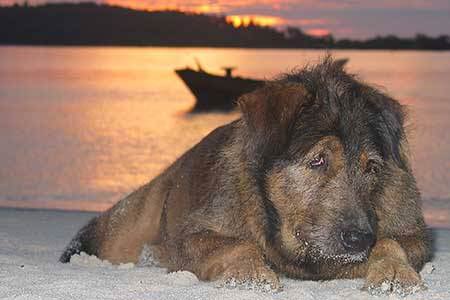
As I stare and click at sunrise over Chaweng beach, somebody suddenly licks my legs. I jump two meters – and say hello to Chaweng's curious beach dogs. I walk on, but they follow decidedly, and heck, don't they accept I'm not to be licked!?
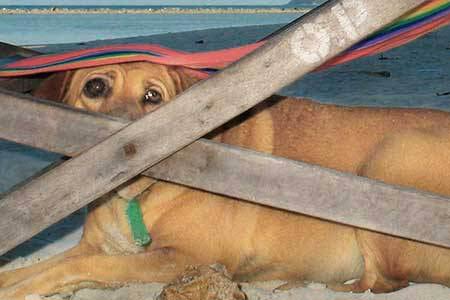
Not only massage ladies, waiters and hawkers form the Thai population on Chaweng beach; canines are another important part. Mind you, not the mangy wrecks of Chaweng beach road or Sukhumvit sois. Yes, the dogs on Chaweng beach also have this frustrated
look like "nobody ever wants to play with me, and why". But their hair is shiny, they are well fed and wear neckties. The dogs are all attached to the resorts. Be careful as you plump into the odd beach chair; should you hear a squeak,
there is Woof seeking shadow down below. They also remove the upper layers of sand to lounge on wetter, cooler grains. Occasionally dogs visit me on my bungalow terrace; we talk a bit, but I won't share snacks, so they move on.
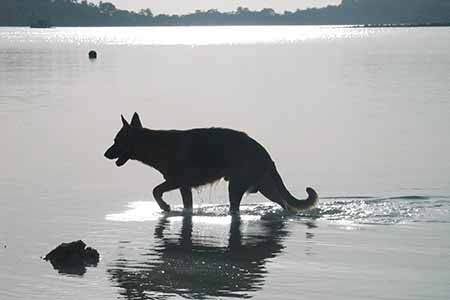
When the tide is low, I watch the dogs squatting in the shallow waters of northern Chaweng beach, looking for crabs. There is especially one delightful young shepherd's dog who is chasing crabs or fish most ambitiously. Never I see them catch anything.
But they won't starve – what I do see is a Thai tourist buying fried fish for a beach dog. Fido trots off with the food and not a single khop khun khrap!
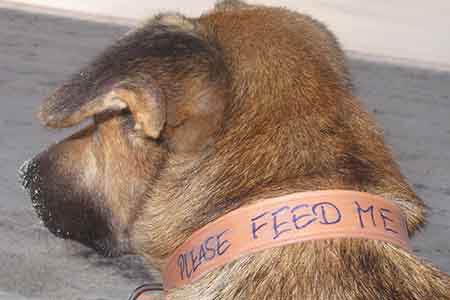
Right on my first walk around Chaweng beach I am very surprised to see a group of Bangkok motorcycle taxi drivers touristing here – they wear the typical colorful numbered vests. But then I realize they are beach hawkers – obviously registered with local
government, and the numbered vest shows that they have the right to offer silk, tattoos, ice-cream, fish, fruit and anything else to boiling-frying-steaming Farangs. Tui says, for the hawking licence they pay something like 300 baht/year to the
government; they must take communal days off and partake in beach cleaning.
One day I sit down in the shadow of the oversized Chom Talay restaurant to apply another layer of sunscreen. This makes me an easy victim. A hawker joins me on the sand and praises his silk wares. I see his black skin, I hear his raw voice and again I
think… I answer "baw ao" one more time, "no need" in Isaan-Lao, and he almost rolls into the water with laughter. He is from Nong Khai in Isaan, and he can't believe I speak a bit of his language. Soon I am ringed by
five hawkers with coloured vests and cheap flashy sunglasses, they forget their business and just want to hear me talk Isaan. They are even more surprised that I know – and like – Thai music like luuk thung, Carabao or Bird. They are all from
Isaan or Laos; not one guy from southern Thailand. After that encounter in the shadow of the luxury restaurant, I have five more friends on the beach; and the number doubles every day, as the incredible news spreads on.
Actually I don't like that much attention. I don't want them to see me on my beachfront terrace. One day I walk up a narrow leafy trail from beach to beach road. I don't see any people, but I hear a shuffle in the bushes. Voice 1: "Phood
Isaan." Voice 2: "Chawp Carabao." (Speaks Isaan. Likes Carabao.) It's too much now.
But then, only my playful talkativeness leads to one of my highlights on Samui. I sit down with some Isaan beach hawkers again, and they ask me if I still do like Carabao. I say yes and inquire if this island has any Carabao. What I mean is if there is
a live cover band, not the dull groups in Soi Green Mango. They say "Chai, mee!" (Yes, have.) I figure they want to tell me I can get Carabao CDs, so I stress my search for a live band. Again, it is "chai, mee". Now I assume
there is really a cover band playing somewhere, maybe in the harbour town of Nathon on the west coast? They swear it is the legendary Carabao band themselves – and it is today! Can it be? I check back with my bungalow reception, and they confirm:
"Yes, Carabao come to Samui. Play today. Not full."
No ten nanoseconds later I sit on my motosai. At 2 p.m. in the hottest sunshine, I roar the three miles over to Wat Plai Laem, where Carabao is supposed to play tonight. Around the pagoda, there is a big market, obviously a kick-off for this new temple.
On a parking lot across the street a stage is built – and I see the moustached Carabao faces from the posters. Funny, in my bungalow I harbour about five kilo of tourist papers, and loudspeaker cars and loudspeaker boats around Chaweng announce
every stupid beer drinking contest – but nowhere was English news about Carabao.
A head monk in the middle of the market sermons into the PA. I manage to get his attention and to retrieve a 200 baht ticket from him. He asks for my name, and as I walk back, the Thai shoppers learn over the speakers that Khun Pothole acquired one ticket
for Carabao tonight.
Tui says, I can go, but I should watch out for fighting drunks. So I play it safe: I go without camera or motosai, but take a motosai taxi, little money and a plastic bag for rain protection. But fortunately there is no rain all night. At the entrance
to the parking lot, I receive a small red plastic stool and am free to choose any place. I pick my neighbours carefully, as later, in the heat of the rhythm, we might dance together, share drinks and mobile numbers. At 9 p.m. about 2000 people
pack the place. There are very few Farangs, and as usual in Thai-oriented places, I am the only Farang without female company. Some white guys have three to five bronze ladies in tow, even though they are less handsome than me!
The evening starts with a guest band doing uninspired country rock. Then it is time for Carabao; this band consists of a bunch of moustached pirates, who play a kind of Thai-spiced version of mainstream rock that appeals to Thais, other Asians and westerners
alike; they perform all over Asia and occasionally in Europe and the US, too; their "Made in Thailand" – with an English refrain – had been a hit in SE Asian countries.
The concert starts with slower songs including the touching "Mae Sai", until it gets rockier and very very rhythmical. Hawkers supply cold drinks for 20 baht. Heck, for great spicy affordable outdoor concerts, Brazil and Thailand are the places
to go. Forget all those lulling Samui spas, for real recreation follow the music. Good clean sanuk! Right behind the open stage they have illuminated a coconut grove – looks great. Bangkok Airways' shining ATR-72 jets zoom along every 20
minutes.
The audience though reminds me a bit of Thongchai's concert videos – the people in the crowd look too rich and boring for average Thais. Different from my experiences in Isaan pubs, only few people start to dance in spite of the very stimulating
beats. Most impressive is this five year old girl – she dances as much as possible on her father's shoulder. When he puts her on a plastic chair, she continues to dance like crazy, even doing the Carabao trademark gesture, the buffalo horn
sign with thumb and little finger. Her own father watches his raving kid bewildered and amused. Made in Thailand!
A few stoned tattooed Thai hippies carry real buffalo horns and howl every line with their idols, but they pose no danger. Only after about three hours and many encores, when we all finally walk out, I see a drunk Thai yelling at the soldiers around the
exit. (Security had been tight because of the unrest in the deep south.) 20 troops stand close-up and hold their guns up, while friends try to drag the molesting drunkard away. I do a big curve around this crowd, and just when I reach the road,
I hear hard hits – he is clubbed down.
The next day I talk it over with Tui on the beach. She is a devout Buddhist and says Carabao made "tamboon" (merit) with their show at Wat Plai Laem. Then she beams affirmatively: As
I had bought a ticket from the monk, I made merit, too. I just hope it is enough kharma for a five-nighter at Amari Palm Reef after reincarnation.
—
Delightful Ko Samui (1/5): Chaweng Beach and People
Delightful Ko Samui (2/5): Chaweng Beach Road and Services
Delightful Ko Samui (3/5): Trips to Lamai and to the South
Delightful Ko Samui (4/5): Waterfalls and Hills
Delightful
Ko Samui (5/5): The North and the West
______
My e-mail: PotholeResearch@aol.com
Stickman's thoughts:
Fantastic! And this is just the first part!



